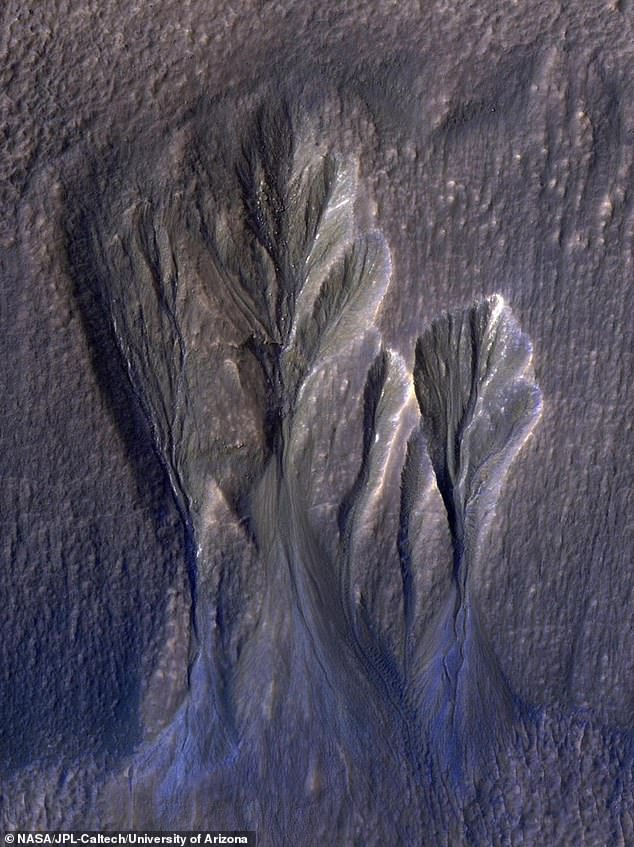A NASA-led study has revealed that there could be extraterrestrial life hidden beneath the icy layers of Mars.
Scientists suggested that the Red Planet’s ancient ice packs may have long acted as a shield for microbial life, blocking deadly cosmic radiation.
But the key to its survival would be ice that likely formed from a dusty snowfall, where sunlight absorbed by that darker dust would allow pockets of meltwater to develop safely beneath its icy surface, the lead author said. , Dr. Aditya Khuller, to DailyMail.com.
Computer models showed that the amount of light passing through water ice could trigger photosynthesis in these shallow pools of meltwater, similar to pools on Earth that are teeming with life.
“These are called ‘cryoconite holes’ and they form when dust and sediment from the ice surface melt into the ice because it is darker than ice,” said Dr. Khuller, who worked as a planetary scientist on the NASA Jet Propulsion Laboratory.
A large number of small plant-like creatures have been documented in Earth’s cryoconite holes, including algae, fungi and cyanobacteria, all of which draw energy from the sun through photosynthesis to live.
“If we’re trying to find life anywhere in the universe today, Martian ice exposures are probably one of the most accessible places we should look,” Dr. Khuller said.
A 2016 image from NASA’s Mars Reconnaissance Orbiter documenting what scientists believe is dusty ice lining the edges of a set of Martian gullies. Planetary scientist Dr. Aditya Khuller and his co-authors believe this ice (pictured) should be an ideal candidate in the search for extraterrestrial life.
These cryoconite colonies have been discovered and studied everywhere from Antarctica to Greenland to the Norwegian archipelago of Svalbard: a chain of islands halfway off the Scandinavian country’s northern coast. and the North Pole.
“Microorganisms usually remain dormant during the winter,” explained Dr. Khuller. space.com“when there is not enough sunlight to form liquid water within dusty ice.”
“Therefore, the two key ingredients for photosynthesis can be found in the dusty Martian ice of the mid-latitudes,” he added. “For photosynthesis to occur, an adequate amount of sunlight and also liquid water is needed.”
The new study builds on Dr. Khuller’s work as a PhD student, when he worked on a project to predict the dust content of ice deposits on Mars, based on data collected by NASA’s Phoenix Mars Lander and its Mars Reconnaissance Orbiter.
The team poured this data into computer simulations that were originally built to predict the brightness of terrestrial snow and glacial ice on Earth.
They theorized that these brightness models built from Earth’s well-studied and better-understood ice would help estimate the dust content mixed with distant Martian ice.
“This small amount of powder has a very important effect,” Dr Khuller told DailyMail.com.
“The depth to which enough sunlight can reach for photosynthesis to occur within the ice changes depending on how dusty the ice is,” he said. “Similarly, the amount of dust within the ice also changes the depth (downward) to which harmful ultraviolet radiation can penetrate.”
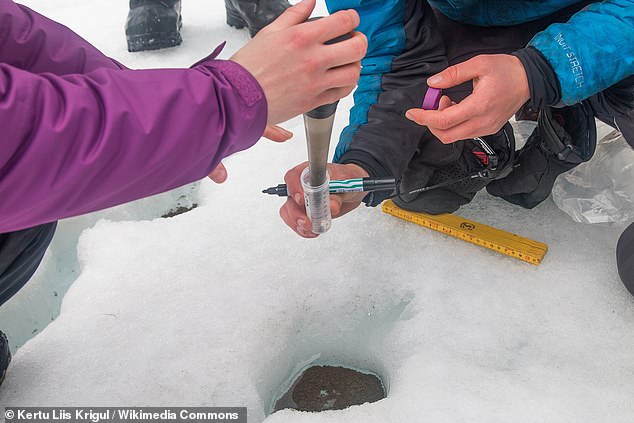
The Martian life that may one day be found in the Red Planet’s dusty ice could resemble life in “cryoconite holes” here on Earth. Above, researchers sample a cryoconite hole in the Longyearbreen glacier, somewhere in the Norwegian archipelago of Svalbard in 2017.
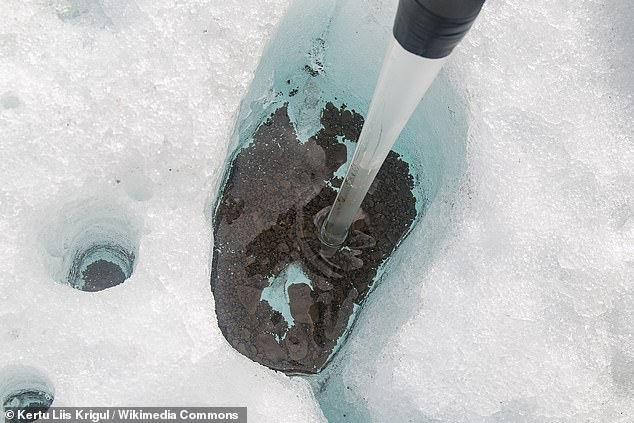
“Microorganisms typically remain dormant in winter, when there is not enough sunlight to form liquid water within dusty ice,” the researchers said. Above, more cryoconite sampling conducted during the same fieldwork for a 2017 Arctic microbiology course in Svalbard.
The team’s computer modeling efforts predicted that ice containing larger amounts of dust, between 0.01 and 0.1 percent, will only be able to support life at a depth of between five and 38 centimeters below the surface.
But Dr Khuller noted: “There are areas where photosynthesis could take place at (…) meters depth to get cleaner ice.”
The cleaner ice was found to be especially fertile territory for deeper pockets of microbial life throughout Mars’ mid-latitudes, both in its northern and southern hemispheres.
At 40° latitude in both hemispheres, these colonies of tiny extraterrestrial life could exist between 2.15 and 3.10 meters deep, according to estimates by Dr. Khuller and his team, published Thursday in the journal Nature Communications. Earth and Environment.
“We do not claim that we have found life on Mars,” Dr. Khuller emphasized to reporters, “but rather we believe that dusty Martian ice exposures in the mid-latitudes represent the most easily accessible places to search for Martian life today.”
But to complicate matters, Mars, unlike Earth, has two different types of natural ice: frozen water and frozen carbon dioxide, in the style of man-made “dry ice.”
Thanks to Mars’ thin, dry atmosphere, planetary and atmospheric scientists are still debating whether melting “water ice” turns into liquid water there, with many arguing that it immediately “sublimates” into water vapor.
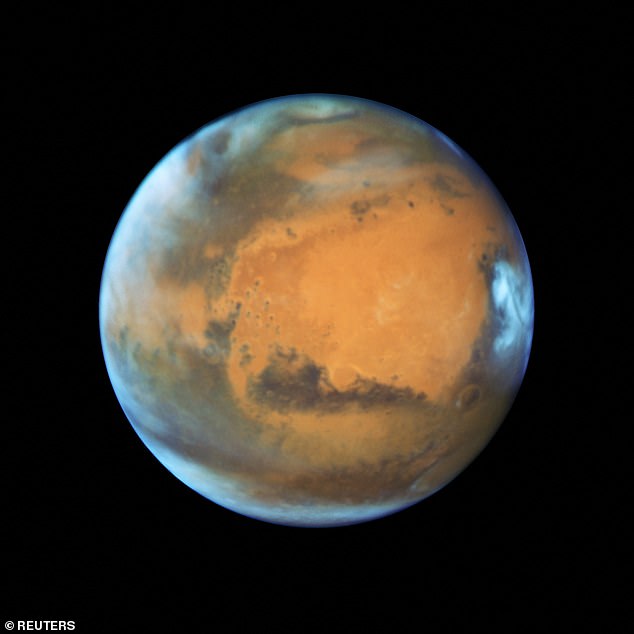
Ice sheets that could support life on Mars were formed by dusty blizzards over dozens of ice ages that hit the Red Planet over the past 5 million years. Above: A May 12, 2016 NASA image taken with the Hubble Space Telescope showing the visible cloud cover of Mars
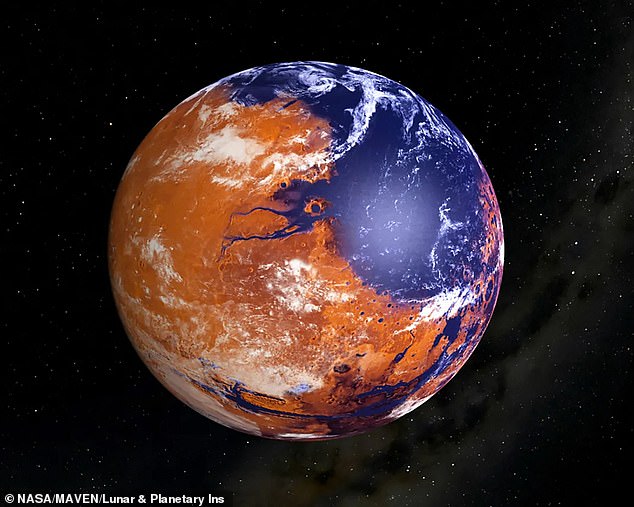
Above, a NASA-funded artist’s concept of what Mars might once have looked like with liquid water (blue regions). Data collected by NASA’s Curiosity rover suggests that Mars was once a life-friendly water world, whose surface later became inhospitable to human and other life.
Melting water ice protected under layers of ice and snow might work better, but there’s still a lot of guesswork in this process, Dr. Khuller said.
“As far as I know, Martian dust is currently believed to have the same composition throughout the planet,” he continued.
“However, we currently do not have any samples of Martian material returned to Earth for detailed analysis,” he added, “so it is difficult to be sure.”
“We would love to have access to samples from the interior of that ice at some point, but that is left to be considered in a future mission.” told DailyMail.com
Big questions remain about whether or not photosynthetic life exists on Mars now or even if it ever existed during its earlier epochs, when it had more liquid water and a stronger magnetosphere to protect it from the sun’s cosmic rays.
But at least for now, Dr. Khuller and his colleagues have helped determine where extraterrestrial life is most likely to exist on the vast 55.74 million square kilometers of Martian surface.
“I am working with a team of scientists to develop improved simulations of if, where and when dusty ice could be melting on Mars today,” Dr Khuller told DailyMail.com.
“In addition, we are recreating some of these dusty ice scenarios in a laboratory to examine them in more detail,” said the researcher, who will join the Applied Physics Laboratory at the University of Washington in Seattle next November.

